
Robinia is a genus of flowering plants in the family Fabaceae, tribe Robinieae, native to North America. Commonly known as locusts, they are deciduous trees and shrubs growing 4–25 metres (13–82 ft) tall. The leaves are pinnate with 7–21 oval leaflets. The flowers are white or pink, in usually pendulous racemes. Many species have thorny shoots, and several have sticky hairs on the shoots.

Iris hartwegii is a species of iris endemic to California, where it can be found on low-elevation mountain slopes in the central counties. It has many common names including; foothill iris, rainbow iris, Sierra iris, and Hartweg's iris.

Tauschia is a genus of flowering plants in the carrot family which are known as umbrellaworts. These are perennial plants with taproots or tubers and foliage generally resembling that of relatives parsley and carrot. Tauschia are native to the Americas.
Arctostaphylos malloryi is a species of manzanita known by the common name Mallory's manzanita. It is endemic to California.

Arctostaphylos refugioensis is a species of manzanita, known by the common name Refugio manzanita. It is endemic to Santa Barbara County, California, where it can be found along the immediate coastline, including the vicinity of Refugio State Beach, and into the Santa Ynez Mountains of the northwestern Transverse Ranges.
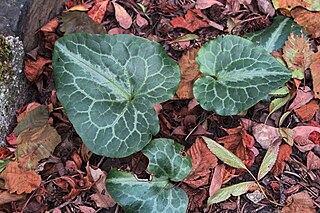
Asarum hartwegii is a species of wild ginger known by the common name Hartweg's wild ginger.
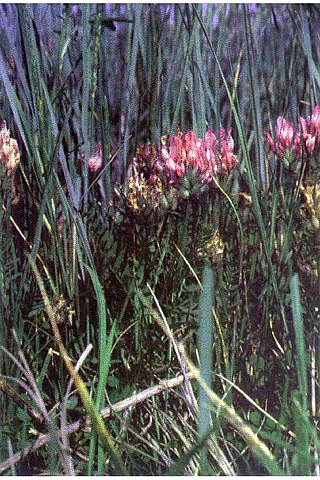
Astragalus agrestis is a species of milkvetch known by the common names purple milkvetch, purple loco, and field milkvetch. It is native to much of western and northern North America from most of Canada to the southwestern United States, as well as eastern Asia. It grows in vernally moist areas such as meadows, and is often found in sagebrush.

Odontostomum is a monotypic genus of flowering plants containing the single species Odontostomum hartwegii, which is known by the common name Hartweg's doll's-lily. In the APG III classification system, it is placed in the family Tecophilaeaceae. It was formerly placed in the Liliaceae. It This wildflower is endemic to northern California, where it can be found in the inner coastal mountain ranges and the Sierra Nevada foothills. It grows in rocky clay and often serpentine soils in grassland and woodland habitat, sometimes near vernal pools. This is a perennial herb growing from an oval-shaped corm up to 3 centimeters wide deep in the soil. The curving, widely branching stem is up to about half a meter in maximum height with linear leaves up to 30 centimeters long sheathing the lower portion. The inflorescence is a raceme or panicle of several flowers on pedicels. Each flower has six white or yellowish tepals, the lower parts fused into a veined tube and the tips spreading and then becoming reflexed. At the center of the flower are six stamens and six staminodes in a ring around the gynoecium.

Pyrrocoma apargioides is a species of flowering plant in the family Asteraceae known by the common name alpineflames. It is native to the western United States from the Sierra Nevada of California east to Utah, where it grows in the forests and meadows of high mountains. It is a perennial herb growing from a taproot and producing one or more stems to 30 centimeters in length. The stems are decumbent or upright, reddish, and hairless to slightly woolly. Most of the leaves are located around the base. They are thick and leathery, lance-shaped with large sawteeth along the edges, often center-striped in white, and measure up to 10 centimeters long. The inflorescence is usually a single flower head lined with centimeter-long phyllaries which are reddish to green with red edges. The head has a center of yellow disc florets and a fringe of ray florets which are yellow, often splashed with red along the undersides, measuring up to 1.6 centimeters in length. The fruit is an achene which may be well over a centimeter in length including its pappus.
Sidalcea hartwegii is a species of flowering plant in the mallow family known by the common names valley checkerbloom and Hartweg's checkerbloom.

Silene noctiflora is a species of flowering plant in the family Caryophyllaceae known by the common names night-flowering catchfly, nightflowering silene and clammy cockle. It is native to Eurasia, but it is known on other continents as an introduced species and sometimes a weed. In North America, it is a common weed of grain crops in the Canadian prairie provinces and in much of the United States. It grows in fields and in other disturbed habitat.

Sisymbrium orientale is a species of flowering plant in the family Brassicaceae known by the common names Indian hedgemustard and eastern rocket. It is native to Europe, Asia, and North Africa, and it can be found throughout much of the temperate world as an introduced species and in some areas a common roadside weed. It is an annual herb producing a hairy, branching stem up to about 30 centimeters tall. The basal leaves are divided into deep lobes or toothed leaflets. Leaves higher on the stem have lance-shaped blades with small separate lobes near the base. The top of the stem is occupied by a raceme of flowers with light yellow petals each measuring up to a centimeter long. The fruit is a silique which can be up to 10 centimeters long.

Spergularia villosa is a species of flowering plant in the family Caryophyllaceae known by the common name hairy sandspurry. It is native to southern South America, and it is known in the southwestern United States and Baja California as an introduced species and casual weed. It grows in a wide variety of habitat types. It is a small perennial herb producing a sprawling stem up to 30 centimeters long with a woody base. It is coated in glandular hairs. The leaves are generally linear in shape and measure a few centimeters long. They are accompanied by dull white lance-shaped stipules. The flowers have hairy, glandular sepals and five oval whitish petals.

Tauschia arguta is a species of flowering plant in the carrot family known by the common name southern umbrellawort. It is native to the mountains of southern California and Baja California, where it grows in local habitat types such as woodlands and chaparral.
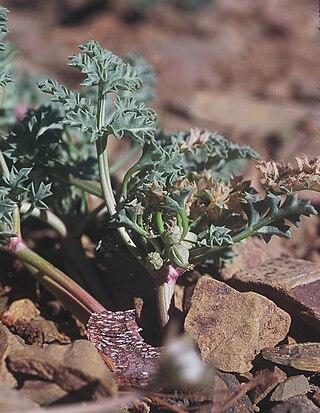
Tauschia howellii is a rare species of flowering plant in the carrot family known by the common names Howell's umbrellawort and Howell's tauschia. It is endemic to the Klamath Mountains of far southern Oregon and far northern California, where it is limited to nine occurrences in the Siskiyou Mountains. It grows in mountain forests on gravelly granite soils, often among stands of Shasta red fir. Despite its rarity it is stable and not considered very endangered. It is a perennial herb growing 30 to 80 centimeters tall. It is hairless in texture. The thick leaves have blades which are divided into leaflets large, sharp teeth and edges curved up, and borne on long petioles. The short inflorescence is a compound umbel of yellow flowers on a few short rays. The fruit is oblong, ribbed, and just a few millimeters long.
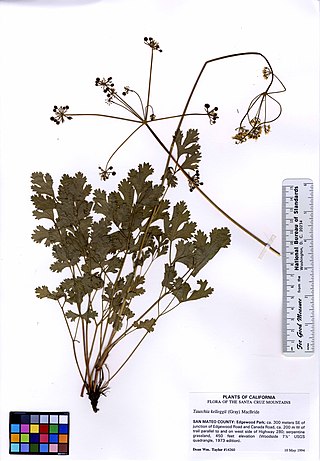
Tauschia kelloggii is a species of flowering plant in the carrot family known by the common name Kellogg's umbrellawort. It is native to the mountains of Oregon and the northern half of California, where it grows in chaparral, woodlands, forest, and other types of habitat. It is a perennial herb growing up to 70 centimeters tall. The leaves have blades which are divided into toothed or serrated leaflets, and sometimes subdivided further. The inflorescence is a compound umbel of yellow flowers with 10 to 20 rays measuring 2 to 12 centimeters long each. The fruit is somewhat rounded in shape, ribbed, and up to half a centimeter long.
Tauschia parishii is a species of flowering plant in the carrot family known by the common name Parish's umbrellawort. It is endemic to California.

Triteleia dudleyi is a species of flowering plant known by the common name Dudley's triteleia. It is endemic to California, where it is known from sections of the High Sierra Nevada and the Transverse Ranges. It is a plant of subalpine climates, growing in mountain forests. It is a perennial herb growing from a corm. It produces two or three basal leaves up to 30 centimeters long by one wide. The inflorescence arises on an erect stem up to 30 or 35 centimeters tall and bears an umbel-like cluster of many flowers. Each flower is a funnel-shaped yellow bloom that dries purple. The flower has six lobes measuring up to 1.2 centimeters long. There are six stamens with lavender anthers.
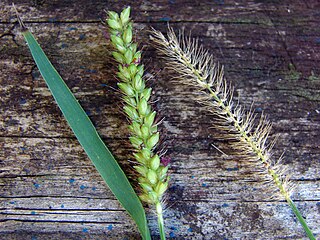
Setaria parviflora is a species of grass known by the common names marsh bristlegrass, knotroot bristle-grass, bristly foxtail and yellow bristlegrass. It is native to North America, including Mexico and the United States from California to the East Coast, Central America and the West Indies, and South America.
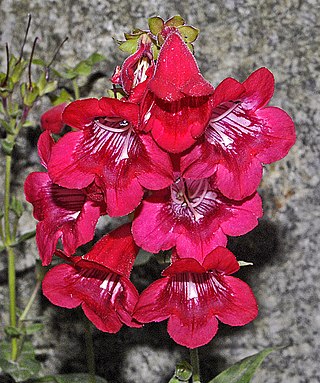
Penstemon hartwegii, common name Hartweg's beardtongue, is a species of flowering perennial herb in the plantain family.















